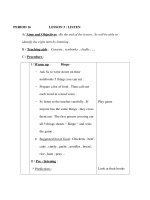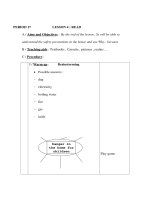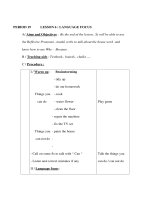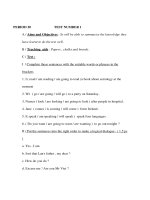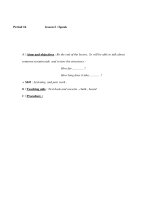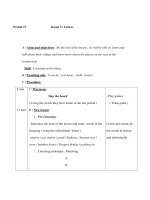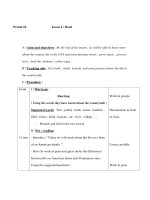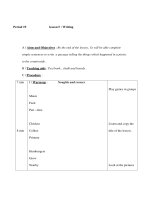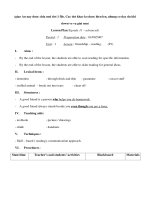Giáo án Anh văn lớp 11 - Unit 3 - Period 19 ppt
Bạn đang xem bản rút gọn của tài liệu. Xem và tải ngay bản đầy đủ của tài liệu tại đây (22.23 KB, 5 trang )
Lesson Plan 1(grade 11 – advanced)
Period : 19 Preparation date : 13/10/2007
Unit : 3 Lesson : Parties – reading.
I. Aims :
- By the end of the lesson, the students are able to scan reading for specific information.
- By the end of the lesson, the students are able to skim reading for general ideas.
II. Lexical items :
- protocol - raise - cutlery - etiquette
- collar - lap - congenial - mouthful
III. Structures :
- Fingers are not to be used except in the case of bread and other similar foods.
- Chew with your mouth closed and, do not talk while chewing.
IV. Teaching aids:
- textbook - picture / drawings
- chalk - handouts
V. Techniques :
- Skill – based ( reading, speaking, writing)
VI. Procedures :
State/time Teacher’s and students’ activities Blackboard Materials
1. Warm-
up & lead-
in
(3’)
checking vocabulary : gap-filling
- Give Sts handouts and ask them to work
in pairs, completing the sentences, using
the words just learned.
1. It is bad …… to talk with
your mouth full.
2. please ……. From
handouts
- set a time limit of 5 minutes
- after Ss have finished, call on some to
give the answers one by one
- check with the class
Summarize the main ideas of p1 and p2
- call on a St to summarize the text which
they learnt last time
- comment and correct them
Transition: to understand more clearly
about the text, today we’ll learn the
comprehension. – Write on the board:
smoking
3. The purpose of a party is
to bring together a group of
people in a …….
Atmosphere
4. they were filled with
anger because such behavior
was totally …… in a
civilized society.
5. After my mother has
finished washing the dishes,
she often put the …… in the
drawer.
Unit3: p19: parties-
comprehension.
Chalk and
board.
2. Pre-
reading
(5’)
Teaching Vocabulary
- write new words on the bb.
- elicit meanings from Sts or give
explanations yourself
- leave some minutes for Sts to copy.
- raise (v) lift up
- protocol (n): manner
- lap (n) : bap dui
- collar (n) : co ao
Chalk and
board
- give some practice on pronunciation ( T
reads – Sts repeat in chorally, then asks
Sts to read individually.)
- cutlery (n) : knives + forks
+ spoons used for eating
- congenial (a) : de chiu
- mouthful (n) : piece of
food
3. while -
reading
(15’)
Activity 1: table completion
- ask Ss to read the text and complete the
table. (task a)
- call on some Ss to give the answers
- ask Ss to write up the answers on the
board
- go over the answers with class.
Activity 2:Practising the “Do’s &
Don’ts’
- Ask Ss to take out the realia they
prepared beforehand ( a plate, a fork, a
spoon, a break knife, a napkin, a tea cup,
a teaspoon, and a soup bowl.)
- Put Ss into pairs
- Students, in pair take turns
demonstrating the table manners listed in
the next.
- after they have finished, choose
Task a :
Do’s :
1. chew with the mouth
closed
2. refrain from coughing or
sneezing at the table.
3. lift soup by the spoon in
movements away from
yourself, not toward
4. put your cutlery to the
side of your plate at the four
and eight o’clock position,
on opposite sides of the
plate, then the waiter won’t
remove your plate
Don’ts:
1. talk white chewing
2. rest elbows on the table
Chalk +
book +
small
board
randomly some table manners and call on
some students to demonstrate them
- invite class opinions and give feedback.
Activity 3: finding references & word
meanings
- Ask Ss to individually do task b, & task
c
- Read out the questions and call on Ss to
give the answers.
- Invite class opinions and make
corrections where necessary.
while there is food.
3. use fingers except in the
case of bread and other
similar foods
4. prepare the next mouthful
while still eating the one
before
Task b:
1. they refers to parties
2. is a way of explaining
talbe manners
3. it refers to the information
coming after the phrase –
the do’s and don’ts which
follow
Task c:
1. lifted 2. etiquette
3. cutlery 4. congenial
Textbooks
chalk
4. Post-
reading
(15’)
Role-play:
- ask pair to make comparisons between
British and Vietnamese table manners
- put an example of the task
A : we are supposed to chew with the
mouth closed. Are you, too?
B: yes, it is good manners to do so. But is
not good to talk while chewing.
A: yes , it is the same as our table
manners.
B: ……
- Monitor the class unobtrusively .
- invite some demonstrations and give
feedback
Textbooks
5.
Homework
(2’)
- Ask Sts to learn new words by heart and
review the today’s lesson.
- Prepare the new lessons for the next
time
Book and
notebook
